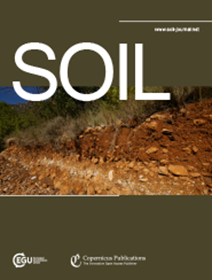Quantifying spatial uncertainty to improve soil predictions in data-sparse regions
IF 4.3
2区 农林科学
Q1 SOIL SCIENCE
引用次数: 0
Abstract
Abstract. Artificial Neural Networks (ANNs) are valuable tools for predicting soil properties using large datasets. However, a common challenge in soil sciences is the uneven distribution of soil samples, which often results from past sampling projects that heavily sample certain areas while leaving similar yet geographically distant regions under-sampled. One potential solution to this problem is to transfer an already trained model to other similar regions. Robust spatial uncertainty quantification is crucial for this purpose, yet often overlooked in current research. We address this issue by using a Bayesian deep learning technique, Laplace Approximations, to quantify spatial uncertainty. This produces a probability measure encoding where the model’s prediction is deemed reliable, and where a lack of data should lead to a high uncertainty. We train such an ANN on a soil landscape dataset from a specific region in southern Germany and then transfer the trained model to another unseen but to some extend similar region, without any further model training. The model effectively generalized alluvial patterns, demonstrating its ability to recognize repetitive features of river systems. However, the model showed a tendency to favor overrepresented soil units, underscoring the importance of balancing training datasets to reduce overconfidence in dominant classes. Quantifying uncertainty in this way allows stakeholders to better identify regions and settings in need of further data collection, enhancing decision-making and prioritizing efforts in data collection. Our approach is computationally lightweight and can be added post-hoc to existing deep learning solutions for soil prediction, thus offering a practical tool to improve soil property predictions in under-sampled areas, as well as optimizing future sampling strategies, ensuring resources are allocated efficiently for maximum data coverage and accuracy.量化空间不确定性以改善数据稀疏地区的土壤预测
摘要。人工神经网络(ann)是利用大数据集预测土壤性质的重要工具。然而,土壤科学的一个共同挑战是土壤样本分布不均匀,这通常是由于过去的采样项目对某些地区进行了大量采样,而对相似但地理上遥远的地区进行了采样不足。这个问题的一个潜在解决方案是将一个已经训练好的模型转移到其他类似的区域。稳健的空间不确定性量化是实现这一目标的关键,但在目前的研究中往往被忽视。我们通过使用贝叶斯深度学习技术,拉普拉斯近似来量化空间不确定性来解决这个问题。这产生了一种概率度量编码,其中模型的预测被认为是可靠的,而数据的缺乏会导致高度的不确定性。我们在德国南部一个特定地区的土壤景观数据集上训练这样一个人工神经网络,然后将训练好的模型转移到另一个看不见但扩展的类似区域,而不需要进一步的模型训练。该模型有效地概括了冲积模式,证明了其识别河流系统重复特征的能力。然而,该模型显示出倾向于过度代表土壤单位的趋势,强调平衡训练数据集以减少对优势类的过度自信的重要性。以这种方式量化不确定性,使利益攸关方能够更好地确定需要进一步收集数据的区域和环境,加强决策并确定数据收集工作的优先次序。我们的方法在计算上是轻量级的,可以添加到现有的深度学习土壤预测解决方案中,从而提供了一个实用的工具来改善采样不足地区的土壤性质预测,以及优化未来的采样策略,确保资源有效分配,以获得最大的数据覆盖率和准确性。
本文章由计算机程序翻译,如有差异,请以英文原文为准。
求助全文
约1分钟内获得全文
求助全文
来源期刊

Soil
Agricultural and Biological Sciences-Soil Science
CiteScore
10.80
自引率
2.90%
发文量
44
审稿时长
30 weeks
期刊介绍:
SOIL is an international scientific journal dedicated to the publication and discussion of high-quality research in the field of soil system sciences.
SOIL is at the interface between the atmosphere, lithosphere, hydrosphere, and biosphere. SOIL publishes scientific research that contributes to understanding the soil system and its interaction with humans and the entire Earth system. The scope of the journal includes all topics that fall within the study of soil science as a discipline, with an emphasis on studies that integrate soil science with other sciences (hydrology, agronomy, socio-economics, health sciences, atmospheric sciences, etc.).
 求助内容:
求助内容: 应助结果提醒方式:
应助结果提醒方式:


